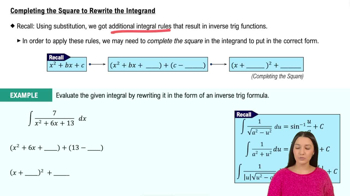Max/min of area functions Suppose ƒ is continuous on [0 ,∞) and A(𝓍) is the net area of the region bounded by the graph of ƒ and the t-axis on [0, x]. Show that the local maxima and minima of A occur at the zeros of ƒ. Verify this fact with the function ƒ(𝓍) = 𝓍² - 10𝓍.
Table of contents
- 0. Functions7h 54m
- Introduction to Functions16m
- Piecewise Functions10m
- Properties of Functions9m
- Common Functions1h 8m
- Transformations5m
- Combining Functions27m
- Exponent rules32m
- Exponential Functions28m
- Logarithmic Functions24m
- Properties of Logarithms36m
- Exponential & Logarithmic Equations35m
- Introduction to Trigonometric Functions38m
- Graphs of Trigonometric Functions44m
- Trigonometric Identities47m
- Inverse Trigonometric Functions48m
- 1. Limits and Continuity2h 2m
- 2. Intro to Derivatives1h 33m
- 3. Techniques of Differentiation3h 18m
- 4. Applications of Derivatives2h 38m
- 5. Graphical Applications of Derivatives6h 2m
- 6. Derivatives of Inverse, Exponential, & Logarithmic Functions2h 37m
- 7. Antiderivatives & Indefinite Integrals1h 26m
- 8. Definite Integrals4h 44m
- 9. Graphical Applications of Integrals2h 27m
- 10. Physics Applications of Integrals 3h 16m
- 11. Integrals of Inverse, Exponential, & Logarithmic Functions2h 34m
- 12. Techniques of Integration7h 41m
- 13. Intro to Differential Equations2h 55m
- 14. Sequences & Series5h 36m
- 15. Power Series2h 19m
- 16. Parametric Equations & Polar Coordinates7h 58m
8. Definite Integrals
Fundamental Theorem of Calculus
Problem 5.R.102c
Textbook Question
Function defined by an integral Let H (𝓍) = ∫₀ˣ √(4 ― t²) dt, for ― 2 ≤ 𝓍 ≤ 2.
(c) Evaluate H '(2) .
 Verified step by step guidance
Verified step by step guidance1
Step 1: Recognize that the function H(𝓍) is defined as an integral, H(𝓍) = ∫₀ˣ √(4 − t²) dt. To find H'(𝓍), we use the Fundamental Theorem of Calculus, which states that if F(𝓍) = ∫ₐˣ f(t) dt, then F'(𝓍) = f(𝓍), provided f is continuous.
Step 2: Apply the Fundamental Theorem of Calculus to H(𝓍). This gives H'(𝓍) = √(4 − 𝓍²), because the integrand √(4 − t²) is continuous for the given domain.
Step 3: Substitute 𝓍 = 2 into the derivative H'(𝓍). This means H'(2) = √(4 − 2²).
Step 4: Simplify the expression inside the square root. Compute 4 − 2², which simplifies to 4 − 4.
Step 5: Conclude that H'(2) = √(0). The derivative at this point is determined by evaluating the square root of the simplified expression.
 Verified video answer for a similar problem:
Verified video answer for a similar problem:This video solution was recommended by our tutors as helpful for the problem above
Video duration:
1mPlay a video:
Was this helpful?
Key Concepts
Here are the essential concepts you must grasp in order to answer the question correctly.
Fundamental Theorem of Calculus
The Fundamental Theorem of Calculus connects differentiation and integration, stating that if F is an antiderivative of f on an interval [a, b], then the integral of f from a to b can be computed as F(b) - F(a). This theorem also implies that if H(x) is defined as an integral of a function, then H'(x) can be found by evaluating the integrand at the upper limit of integration.
Recommended video:

Fundamental Theorem of Calculus Part 1
Differentiation of an Integral Function
When differentiating a function defined by an integral, such as H(x) = ∫₀ˣ f(t) dt, the derivative H'(x) can be computed using the integrand evaluated at the upper limit. Specifically, H'(x) = f(x), provided that f is continuous on the interval. This principle simplifies the process of finding derivatives of integral-defined functions.
Recommended video:

Integrals Resulting in Basic Trig Functions Example 1
Evaluating the Integrand
To evaluate H'(2) in the given problem, we first need to identify the integrand, which is √(4 - t²). We then substitute the upper limit of integration, x = 2, into the integrand. This step is crucial as it allows us to find the value of the derivative at that specific point, which is essential for solving the problem.
Recommended video:

Completing the Square to Rewrite the Integrand

 6:11m
6:11mWatch next
Master Fundamental Theorem of Calculus Part 1 with a bite sized video explanation from Patrick
Start learningRelated Videos
Related Practice
Textbook Question
14
views
